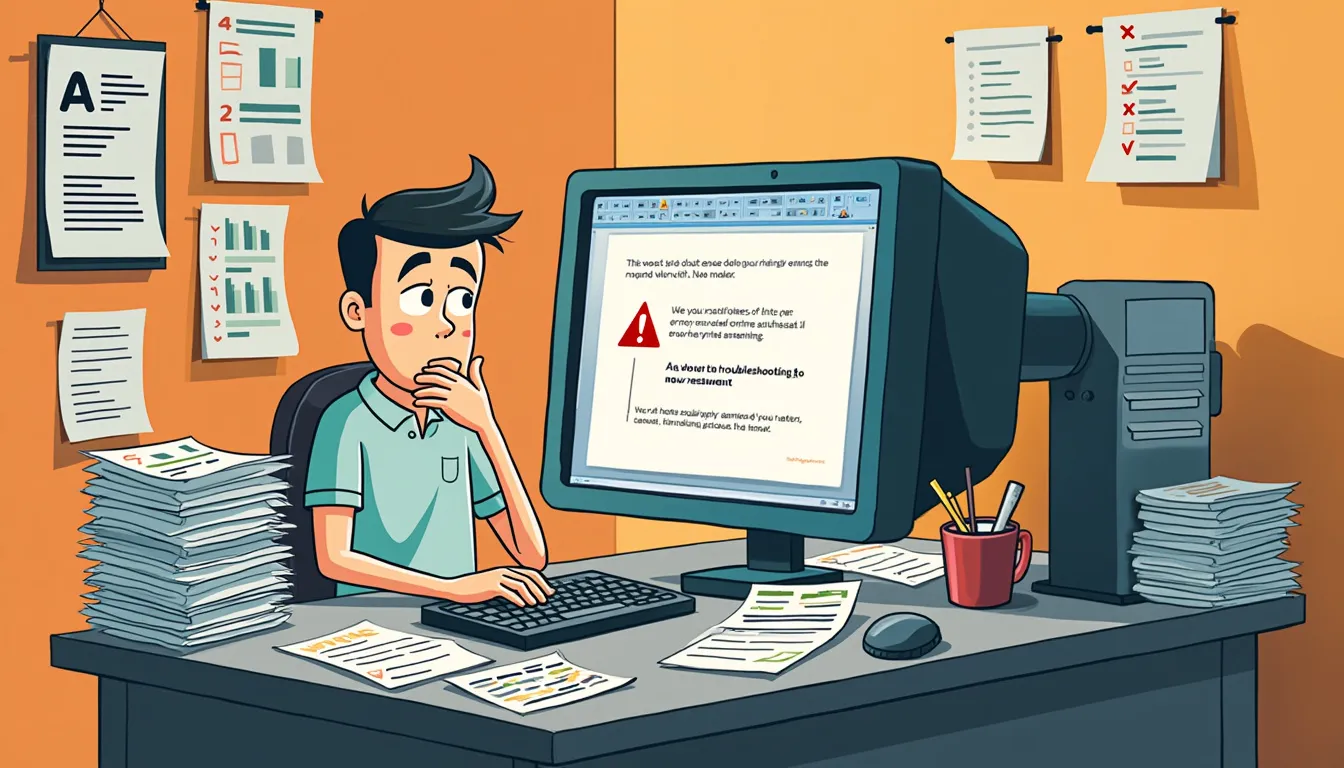Last Updated: September 11, 2024
Are you tired of staring at baffling Microsoft Word mail merge errors that throw a wrench in your carefully crafted documents? You’re not alone! Mail merge is a fantastic tool for creating personalized letters, invitations, or even labels, but those pesky errors can really put a damper on your productivity. In this guide, we’ll walk you through how to troubleshoot Microsoft Word mail merge errors, so you can get back to what you do best—creating amazing documents without the headaches.
We’ll dive into the ins and outs of mail merge, identify common mistakes, and provide a step-by-step troubleshooting guide to get your project back on track. Whether you’re dealing with missing fields, formatting issues, or incorrect data sources, our friendly advice will make those errors disappear faster than a magician’s rabbit. Let’s get started and make those mail merge troubles a thing of the past!
Table Of Contents
Understanding Mail Merge in Microsoft Word
Mail Merge in Microsoft Word is like the superhero of document management. In simpler terms, it allows you to create personalized documents, such as letters, labels, and envelopes, by combining a template with a data source. The magic happens when you have a list of names and addresses, and you want to create individual letters for each. Before you jump into the troubleshooting realm, let’s explore the nuts and bolts of Mail Merge!
What is Mail Merge?
Mail Merge is a powerful feature in Microsoft Word that streamlines the process of sending personalized mass communications. Imagine you want to send out invitations for a party, gratitude cards for your clients, or bills for your freelance work. Instead of typing each document manually, Mail Merge lets you automate the repetitive parts while keeping the personalized touch.
Common Scenarios Where Mail Merge is Used
- Business letters: Send offers, reminders, or updates to clients without the hassle of typing each letter from scratch.
- Marketing materials: Create personalized flyers or brochures that resonate with your target audience.
- Event invitations: Send out guest invites with ease, ensuring all names and addresses are perfectly matched.
- Labels: Print mailing labels for products or correspondence, allowing for quick and scalable mailing.
Why is Troubleshooting Mail Merge Errors Important?
Understanding how to troubleshoot Microsoft Word mail merge errors effectively can save you a significant amount of time and frustration. Below are a few reasons why addressing these errors promptly is crucial:
- Time Efficiency: Resolving issues quickly means less time wasted trying to figure out what went wrong.
- Professional Appearance: Well-executed mail merges to maintain a professional image, ensuring that your documents look just right.
- Cost Effectiveness: Prevent errors in financial documents to avoid costly mistakes like sending out incorrect billing information.
- Enhanced Communication: Ensure your message reaches the intended recipients accurately, which fosters better relationships.
The Process of Mail Merge
Though we’re focusing on troubleshooting, it’s helpful to know a bit about the process. Here’s a brief breakdown:
| Step | Description |
|---|---|
| 1. | Choose Document Type: Select the type of document you’d like to create (letters, labels, etc.). |
| 2. | Prepare Your Data: Ensure your data (names, addresses) is in a clean format, ideally in an Excel spreadsheet. |
| 3. | Start the Mail Merge: Use the Mail Merge Wizard in Microsoft Word to guide you through the process. |
| 4. | Insert Merge Fields: Place where you want the personalized information to appear in your document. |
| 5. | Finish & Merge: Generate the final documents by merging the email addresses into the template. |
Understanding the basic layout of Mail Merge and its importance can create a smoother experience and is the first step in effectively troubleshooting Microsoft Word mail merge errors.
Final Thoughts
Now that you’ve got your head wrapped around what Mail Merge is and how it works, you’re set up perfectly to identify and troubleshoot Microsoft Word mail merge errors. Remember, knowing what to expect is half the battle won!
For more resources, check out Microsoft’s official support page here or visit forums like Reddit’s Office 365 community for real-world advice from fellow users.

Identifying Common Mail Merge Errors
When you’re knee-deep in creating the ideal document with Mail Merge, encountering hiccups is as common as a Monday morning! Fear not! This section will help you understand how to spot those pesky problems and get back on track. So, let’s grab our detective hats and reveal the most common Mail Merge errors!
Common Mail Merge Issues
Here’s a list of frequent Mail Merge issues you may face while working in Microsoft Word:
- Missing Fields: Sometimes, data might not appear because certain fields are empty in the data source.
- Incorrect Data Sources: It’s like bringing the wrong dish to a potluck! Ensure your data source is the right one.
- Formatting Problems: Your document may look like a jigsaw puzzle if the formatting isn’t aligned!
- Field Mismatches: Field names in the data source and in your Mail Merge document may just not play nice.
- Corrupted Data: Sometimes, the data itself can be corrupted, resulting in errors during the merge process.
Recognizing Specific Error Messages
When things go awry, you might see some error messages that’ll make you scratch your head. Here’s a step-by-step guide to recognizing common error messages and what they often mean:
1. “The merge field is empty”
This indicates that one or more fields in your data source don’t have values. Double-check the data source for empty cells.
2. “Cannot open the data source”
It’s like trying to read someone’s handwriting – if it’s not accessible, you can’t use it! This means your data source file might be missing or the path is incorrect.
3. “Invalid merge field”
This occurs when the field in your document doesn’t match the field name in your data source. Ensure they’re identical.
4. “Data source is corrupted”
If you see this, it’s a sign that the data file has been messed up. Try to recreate or restore the file.
5. “Too many empty fields”
If the fields in your document outnumber the available data, this message pops up. You need to ensure your data source provides enough info.
Initial Checks Before Troubleshooting
Let’s not dive deeper before taking a few initial checks! Sometimes, the simplest solutions can resolve your issues. Here are some tips for initial checks:
- Check the Data Source: Open your data source (Excel file, Access database, etc.) and ensure that all fields that you plan to merge are filled in and the data is correct.
- Verify Field Names: Make sure the field names in your Word document match those in your data source. A single typo can throw a wrench in the works!
- Preview Your Merge: Before you complete the merge, use the preview feature in Word to check that the data appears as expected.
- Ensure the Correct Document Type: Make sure you’re not trying to merge into a non-supported document type (like a protected document).
Now that you have a clearer understanding of identifying common Mail Merge errors, you can tackle these pesky problems with confidence! Ready to move forward and actually troubleshoot Microsoft Word mail merge errors? Great!
For expanding your troubleshooting skills or when the going gets tough, don’t forget to check out official resources like Microsoft Support or related forums such as Microsoft Answers for additional tips!

Step-by-Step Troubleshooting Solutions
When it comes to mail merges in Microsoft Word, there’s nothing more frustrating than encountering errors. However, fear not! Today, we’re going to dive into some effective strategies to troubleshoot Microsoft Word mail merge errors. Ready to roll up your sleeves? Let’s get started!
1. Fixing Data Source Issues
- Check the Connection: Ensure that the data source (Excel sheet, Access database, etc.) is correctly connected.
- Validate the Path: Sometimes, errors occur because the path to the data source has changed. Double-check your file location!
- Table Formatting: Ensure your data source is formatted as a table. This helps Word recognize the fields easily!
Tip: To reconnect your data source, go to the Mailings tab, click Select Recipients, and then choose Use an Existing List. Navigate to your data source and select it again.
2. Correcting Field Mismatches
- Match Fields: Ensure that the merge fields in your document correspond to the column headers in your data source.
- Field Format: Check if some fields in your data source contain inconsistent data (like text in a number field).
- Remove Blank Fields: If your data source contains blank fields that could lead to errors, consider removing or replacing those fields.
To fix field issues, click on the Mailings tab, then select Edit Individual Letters. This visual representation helps you see the mismatches and allows easy adjustments.
3. Troubleshooting Formatting and Style Problems
- Default Styles: Conflicting styles can sometimes cause issues. Select all text and set it to a default style, then reapply custom styles as needed.
- Spacing Issues: If your letters are looking cluttered, check for extra spaces before or after merge fields. Maintain proper spacing for clarity!
- Font Compatibility: Ensure you’re using universally compatible fonts. Fonts that aren’t installed on a printer could lead to malformatted letters.
Pro tip: Utilize the Preview Results feature in the Mailings tab to see how your final document might look. It’s a little sneak peek that eliminates surprises later on!
4. Additional Resources for Advanced Troubleshooting
If you’re still battling errors after trying the above steps, don’t despair! Here are some additional resources to help you troubleshoot Microsoft Word mail merge errors more effectively:
| Resource | Link | Description |
|---|---|---|
| Microsoft Support | support.microsoft.com/en-us/word | Official Microsoft resource with guides and FAQs. |
| Tech Community Forums | techcommunity.microsoft.com | Forums where you can ask specific questions and get solutions from experienced users. |
| YouTube Tutorials | youtube.com | Video tutorials that visually demonstrate troubleshooting tips. |
By leveraging these resources, you can banish the remaining stubborn errors and enjoy a seamless mail merge experience.
Now that you have an arsenal of solutions at your disposal, you’ll be well equipped to handle just about any issue that might pop up during your mail merge. Let’s get back to creating those stunning, personalized documents!
Remember, if all else fails, take a break, grab a cup of coffee, and return with a fresh pair of eyes. Sometimes the best solutions come when you least expect them!
And remember, you can always return to this guide whenever you need to troubleshoot Microsoft Word mail merge errors.
Conclusion
Effectively troubleshooting Microsoft Word mail merge errors is key to ensuring your documents look professional and function as intended. By understanding the basics of mail merge and recognizing common errors, you can identify issues quickly and implement the step-by-step solutions provided. Remember, problems such as missing fields, incorrect data sources, or pesky formatting issues can happen to anyone, but with the right approach, they can be resolved with ease.
Don’t forget to leverage additional resources like Microsoft support or various online forums for more in-depth help. In the long run, mastering the art of troubleshooting will not only save you time but also allow you to produce flawless mail merge documents that create a lasting impression. So the next time you get tangled in a web of mail merge errors, fear not! With the tips provided, you’ll navigate through them like a pro.





